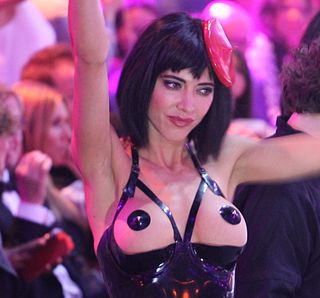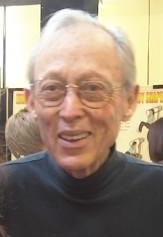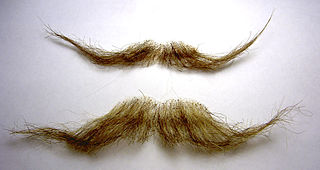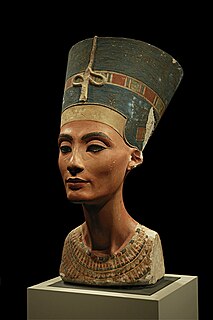In philately, gum is the substance applied to the back of a stamp to enable it to adhere to a letter or other mailed item. The term is generic, and applies both to traditional types such as gum arabic and to synthetic modern formulations. Gum is a matter of high importance in philately.

Prosthetic makeup is the process of using prosthetic sculpting, molding and casting techniques to create advanced cosmetic effects. Prosthetic makeup goes back to the beginning of film making with A Trip to the Moon, a 1902 French adventure short film directed by Georges Méliès where the man on the moon effect was accomplished using a combination of makeup and a prosthetic type mask with added pastes. The makeup artist Jack Pierce was another early Hollywood make-up artist, best remembered for creating the iconic makeup worn by Boris Karloff in Frankenstein, his makeup for the Wolfman, and more. Modern prosthetic makeup was revolutionized by John Chambers, whose work can be seen in Planet of the Apes, as well as Dick Smith's work in Little Big Man, Stan Winston in the Terminator series, and Rob Bottin in The Thing.

Stagecraft is a technical aspect of theatrical, film, and video production. It includes constructing and rigging scenery; hanging and focusing of lighting; design and procurement of costumes; make-up; stage management; audio engineering; and procurement of props. Stagecraft is distinct from the wider umbrella term of scenography. Considered a technical rather than an artistic field, it is primarily the practical implementation of a scenic designer's artistic vision.

Rosin, also called colophony or Greek pitch, is a solid form of resin obtained from pines and some other plants, mostly conifers, produced by heating fresh liquid resin to vaporize the volatile liquid terpene components. It is semi-transparent and varies in color from yellow to black. At room temperature rosin is brittle, but it melts at stove-top temperature. It chiefly consists of various resin acids, especially abietic acid. The term colophony comes from colophonia resina, Latin for "resin from Colophon", an ancient Ionic city.
A facial prosthetic or facial prosthesis is an artificial device used to change or adapt the outward appearance of a person's face or head.

Pasties are patches that cover a person's nipples and areolae, typically self-adhesive or affixed with adhesive. They originated as part of burlesque shows, providing a commercial form of bare-breasted entertainment, and they are commonly associated with strippers and erotic entertainment. They are also, at times, worn as an undergarment, beachwear, fashion, or as a form of protest during women's rights events such as Go Topless Day to avoid potential prosecution under indecency laws.

Richard Emerson Smith was an American special make-up effects artist and author, known for his work on such films as Little Big Man, The Godfather, The Exorcist, Taxi Driver, Scanners and Death Becomes Her. He won a 1985 Academy Award for Best Makeup for his work on Amadeus and received a 2012 Academy Honorary Award for his career's work.

A make-up artist, also called a makeup artist, and often shortened to MUA, is an artist whose medium is the human body, applying makeup and prosthetics on others for theatre, television, film, fashion, magazines and other similar productions including all aspects of the modeling industry. Awards given for this profession in the entertainment industry include the Academy Award for Best Makeup and Hairstyling, and entertainment industry awards such as the Emmy Awards, and the Golden Globes. In some countries professional licenses are required by agencies in order for them to hire the MUA. Bigger production companies have in-house makeup artists on their payroll although most MUA's generally are freelance and their times remain flexible depending on the project.

Maksymilian Faktorowicz, also known as Max Factor Sr., was a Polish-American businessman, beautician, entrepreneur and inventor. As a founder of the cosmetics giant Max Factor & Company, he largely developed the modern cosmetics industry in the United States and popularized the term "make-up" in noun form based on the verb.

A fake moustache or false moustache is an item of prosthetic make-up used in dressing-up, acting, espionage and crime. Fake moustaches are made in different ways, but usually require the wearer to use adhesive to affix the moustache to their face. Some have a self-adhesive backing. National fake moustache day in the United States is on 24 February, while the international celebration is on 3 February. Mr. Pontipine, from In The Night Garden, has a fake moustache.

Sealant is a substance used to block the passage of fluids through openings in materials, a type of mechanical seal. In building construction sealant is sometimes synonymous with caulking and also serve the purposes of blocking dust, sound and heat transmission. Sealants may be weak or strong, flexible or rigid, permanent or temporary. Sealants are not adhesives but some have adhesive qualities and are called adhesive-sealants or structural sealants.
A theatrical technician is a person who operates technical equipment and systems in the performing arts and entertainment industry. In contrast to performers, this broad category contains all "unseen" theatrical personnel who practice stagecraft and are responsible for the logistic and production-related aspects of a performance including designers, operators, and supervisors.

The history of cosmetics spans at least 7,000 years and is present in almost every society on earth. Cosmetic body art is argued to have been the earliest form of a ritual in human culture. The evidence for this comes in the form of utilised red mineral pigments including crayons associated with the emergence of Homo sapiens in Africa. Cosmetics are mentioned in the Old Testament—2 Kings 9:30 where Jezebel painted her eyelids—approximately 840 BC—and the book of Esther describes various beauty treatments as well.

Spinifex resin is a gum coating of some species of spinifex grasses. This sticky resin was traditionally used as an adhesive in tool making by Aboriginal Australians. Many species of spinifex are extremely resinous, to the extent that resin may drip down the stems and leaves on hot days, and large residual lumps of resin often may be seen at the bases of hummocks which have burned.

Adhesive tape is one of many varieties of backing materials coated with an adhesive. Several types of adhesives can be used.

A bald cap is a wig-like cap simulating the appearance of a bald or partially bald head. As part of an actor's make-up, it is often used to make a person appear older. Bald caps are a versatile medium. They form the basis of many creative fantasy make-ups.
Peter King, also known as Peter Swords King, is a British Oscar-winning makeup artist who won at the 2003 Academy Awards for Best Makeup for the film The Lord of the Rings: The Return of the King. He shared the award with filmmaker Richard Taylor. He was nominated again at the 2012 Academy Awards for The Hobbit: An Unexpected Journey.

Mike Elizalde is a Mexican-American special make-up effects artist. He was nominated at the 81st Academy Awards in the category of Best Makeup for his work on the film Hellboy II: The Golden Army. His nomination was shared with Thomas Floutz.

Creature suits are realistic costumes used to disguise a performer as an animal, monster, or other being. They are used in film, television, or as costumed characters in live events. Unlike mascots, they are often made with a high degree of realism. In contrast with prosthetic makeup, which is applied to an actor's skin, the wearer is not normally visible outside their movements controlling the costume, although in some cases, part of the wearer's body is still visible.















